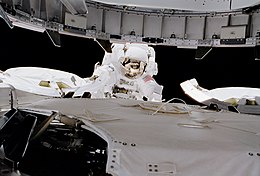
Yuri Ivanovich Malenchenko is a retired Russian cosmonaut. Malenchenko became the first person to marry in space, on 10 August 2003, when he married Ekaterina Dmitrieva, who was in Texas, while he was 240 miles (390 km) over New Zealand, on the International Space Station. As of June 2016, Malenchenko ranks second for career time in space due to his time on both Mir and the International Space Station (ISS). He is a former commander of the International Space Station.

Michael López-Alegría is an astronaut, test pilot and commercial astronaut with dual nationality, American and Spanish; a veteran of three Space Shuttle missions and one International Space Station mission. He is known for having performed ten spacewalks so far in his career, presently holding the second longest all-time EVA duration record and having the fifth-longest spaceflight of any American at the length of 215 days; this time was spent on board the ISS from September 18, 2006 to April 21, 2007. López-Alegría commanded Axiom-1, the first ever all-private team of commercial astronaut mission to the International Space Station, which launched on April 8, 2022 and spent around 17 days in earth's orbit.

STS-112 was an 11-day Space Shuttle mission to the International Space Station (ISS) flown by Space ShuttleAtlantis. Space Shuttle Atlantis was launched on 7 October 2002 at 19:45 UTC from the Kennedy Space Center's launch pad 39B to deliver the 28,000 pound Starboard 1 (S1) truss segment to the Space Station. Ending a 4.5-million-mile journey, Atlantis landed at 15:44 UTC on 18 October 2002 on runway 33 at the Kennedy Space Center's Shuttle Landing Facility.
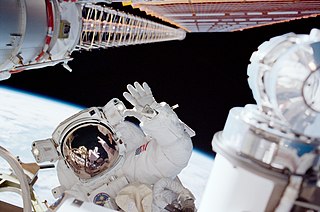
STS-97 was a Space Shuttle mission to the International Space Station (ISS) flown by Space Shuttle Endeavour. The crew installed the first set of solar arrays to the ISS, prepared a docking port for arrival of the Destiny Laboratory Module, and delivered supplies for the station's crew. It was the last human spaceflight of the 20th century.
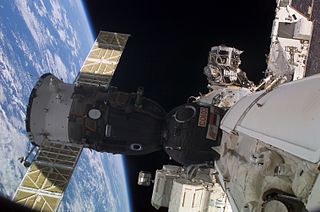
Expedition 7 was the seventh expedition to the International Space Station.

STS-116 was a Space Shuttle mission to the International Space Station (ISS) flown by Space Shuttle Discovery. Discovery lifted off on December 9, 2006, at 20:47:35 EST. A previous launch attempt on December 7 had been canceled due to cloud cover. It was the first night launch of a Space Shuttle since STS-113 in November 2002.

STS-117 was a Space Shuttle mission flown by Space Shuttle Atlantis, launched from pad 39A of the Kennedy Space Center on June 8, 2007. Atlantis lifted off from the launch pad at 19:38 EDT. Damage from a hail storm on February 26, 2007, had previously caused the launch to be postponed from an originally-planned launch date of March 15, 2007. The launch of STS-117 marked the 250th orbital human spaceflight.
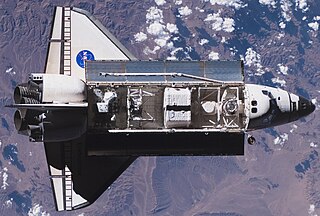
STS-118 was a Space Shuttle mission to the International Space Station (ISS) flown by the orbiter Endeavour. STS-118 lifted off on August 8, 2007, from launch pad 39A at Kennedy Space Center (KSC), Florida and landed at the Shuttle Landing Facility at KSC on August 21, 2007.

STS-119 was a Space Shuttle mission to the International Space Station (ISS) which was flown by space shuttle Discovery during March 2009. It delivered and assembled the fourth starboard Integrated Truss Segment (S6), and the fourth set of solar arrays and batteries to the station. The launch took place on March 15, 2009, at 19:43 EDT. Discovery successfully landed on March 28, 2009, at 15:13 pm EDT.

STS-120 was a Space Shuttle mission to the International Space Station (ISS) that launched on October 23, 2007, from the Kennedy Space Center, Florida. The mission is also referred to as ISS-10A by the ISS program. STS-120 delivered the Harmony module and reconfigured a portion of the station in preparation for future assembly missions. STS-120 was flown by Space ShuttleDiscovery, and was the twenty-third Space Shuttle mission to the ISS.
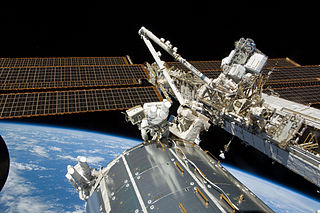
STS-129 was a NASA Space Shuttle mission to the International Space Station (ISS). Atlantis was launched on November 16, 2009, at 14:28 EST, and landed at 09:44 EST on November 27, 2009, on runway 33 at the Kennedy Space Center's Shuttle Landing Facility. It was also the last Shuttle mission of the 2000s.

STS-131 was a NASA Space Shuttle mission to the International Space Station (ISS). Space ShuttleDiscovery launched on April 5, 2010, at 6:21 am from LC-39A, and landed at 9:08 am on April 20, 2010, on runway 33 at the Kennedy Space Center's Shuttle Landing Facility. The mission marked the longest flight for Space Shuttle Discovery.

STS-132 was a NASA Space Shuttle mission, during which Space Shuttle Atlantis docked with the International Space Station on May 16, 2010. STS-132 was launched from the Kennedy Space Center on May 14, 2010. The primary payload was the Russian Rassvet Mini-Research Module, along with an Integrated Cargo Carrier-Vertical Light Deployable (ICC-VLD). Atlantis landed at the Kennedy Space Center on May 26, 2010.

Expedition 15 was the 15th expedition to the International Space Station (ISS). Four crew members participated in the expedition, although for most of the expedition's duration only three were on the station at any one time. During Expedition 15, the ISS Integrated Truss Structure was expanded twice: STS-117 brought the S3/S4 truss, and STS-118 brought the S5 truss.
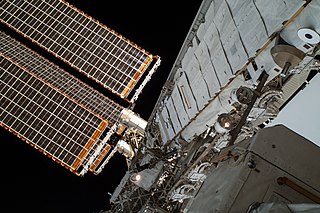
The Integrated Truss Structure (ITS) of the International Space Station (ISS) consists of a linear arranged sequence of connected trusses on which various unpressurized components are mounted such as logistics carriers, radiators, solar arrays, and other equipment. It supplies the ISS with a bus architecture. It is approximately 110 meters long and is made from aluminum and stainless steel.

The Pressurized Mating Adapter (PMA) is a class of spacecraft adapters that convert the Common Berthing Mechanism (CBM) used on the US Orbital Segment to APAS-95 docking ports. There are three PMAs located on the International Space Station (ISS); the first two were launched with the Unity connecting module in 1998 aboard STS-88, and the third was launched in 2000 aboard STS-92. All three of the PMAs are now used to permanently connect parts of the ISS, so they are no longer available as docking ports for visiting spacecraft.

NASA Astronaut Group 13 was a group of 23 astronauts announced by NASA on 17 January 1990. The group name came from its selection of a black cat as a mascot, to play against the traditional unlucky connotations of the number 13.
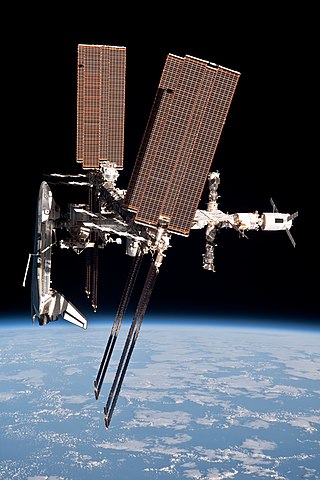
STS-134 was the penultimate mission of NASA's Space Shuttle program and the 25th and last spaceflight of Space ShuttleEndeavour. This flight delivered the Alpha Magnetic Spectrometer and an ExPRESS Logistics Carrier to the International Space Station. Mark Kelly served as the mission commander. STS-134 was expected to be the final Space Shuttle mission if STS-135 did not receive funding from Congress. However, in February 2011, NASA stated that STS-135 would fly "regardless" of the funding situation. STS-135, flown by Atlantis, took advantage of the processing for STS-335, the Launch on Need mission that would have been necessary if the STS-134 crew became stranded in orbit.

NASA Astronaut Group 16 was a group of 44 astronauts announced by NASA on May 1, 1996. The class was nicknamed "The Sardines" for being such a large class, humorously implying that their training sessions would be as tightly packed as sardines in a can. These 44 candidates compose the largest astronaut class to date. NASA selected so many candidates in preparation for the anticipated need for ISS crew members, along with regular shuttle needs. Nine of the 44 astronauts selected were from other countries including 5 from Europe and 2 from Canada and Japan.
